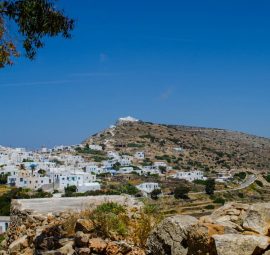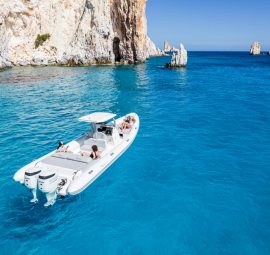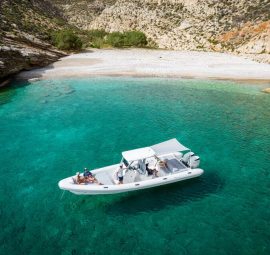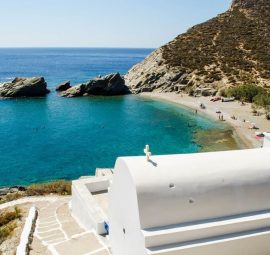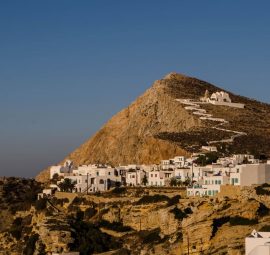Wild, Authentic Scenery and Free Spirit Mentality
Folegandros is a small Cycladic treasure that has managed to remain quiet away from the mass tourism and preserve its authentic character. This barren land captivates the eyes of the travelers with its wild beauty. Here you will come across whitewashed houses, labyrinthine alleys, charming churches, an old medieval castle, archeological monuments, traditional villages, pristine beaches and warm hearted locals. This small island has nothing to be jealous from its cosmopolitan neighbors, the islands of Paros and Santorin. In fact, Folegandros offers a true Cycladic experience away from the crowds to those looking to relax and enjoy the pure Greek treasures: the sun, the sea and amazing food!HightLights
- Chrysospilia: is a marvelous cave and a unique natural monument. This impressive cave is one of the biggest in Greece. It is located on the northeastern side of the island, about 10 meters above the sea level. It has a length of 300m and contains two main chambers with rich stalactite and stalagmite formations. Chrysospilia is of great archeological interest, as it is believed that it used to be a place of worship and coming-of-age rituals in antiquity. In its walls hundreds of carved ancient names dating back to the 4th century have been discovered. The inscriptions are believed to belong to young adults who managed to enter the cave’s chamber and leave a trace of their visit. Findings of human bones in the entrance of the cave have led archeologists to believe that it was also used as a shelter from the pirates during the Roman domination. Although there are steps leading to the cave built in antiquity, known as the “Hellenic steps”, access to the cave from the land or sea is very difficult. The cave is not open to the public, since there are ongoing archeological investigations. Travelers usually visit the cave from the sea and take a quick glimpse of this unique natural formation, and it is said that there are ancient hiking paths available leading from Chora to the inside of the cave, possibly used by the locals in the old times.
- Pantanassa Church: is located in the western side of Kastro. It was built in the 18th century and is considered the most beautiful church in Folegandros, with many well known works of art decorating the interior of the church. The church offers also great views of Milos and Kimolos islands.
- Panagia’s Church: is the island’s most significant church, dedicated to the Assumption of the Virgin Mary. It is built on the hill above Chora on the foundations of an ancient temple. In fact, both in the courtyard and inside the church there are ancient epigraphs, sculptures and statues bases. Panagia used to be a nunnery and took its current form after a reconstruction that was completed in 1821. The church houses a Byzantine icon of the Virgin Mary that is said to have miraculous powers and is linked with pirate stories and legends of Folegandros. On Easter the icon is carried to all the homes of the island. Panagia is reached by following an uphill path (15min) from Pounta square.
- Kastro: is the oldest part of Chora. It is a medieval fortified settlement built in 1212 by Marco Sanudo at the edge of a cliff in order to protect islanders from pirate attacks. Kastro is still inhabited and offers amazing views of the island and the Aegean sea. Within the settlement you will find unique old houses, some of which are over 100 years old, and picturesque churches that will travel you back in time.
- Aspropounta Lighthouse: is an impressive lighthouse built in 1919 in an altitude of 58 meters above sea level. Its beacon is 11 meter tall and its light is visible at a distance of 17 nautical miles. It can easily be accessed on foot either from Livadaki (15min) or Pano Meria (60 min).
- Ecomuseum: is located in Ano Meria. The museum represents atypical Folegandros farmhouse of the 19th century, known as “themonia”. The museum consists of four buildings featuring furniture, oven, cellar, oil-press, and vineyard, grape–pressing floor, threshing floor, laundry installation, tools, utensils and library.
Towns & Villages
Chora
Chora is considered one of the most beautiful villages in Cyclades. Visitors are immediately drawn to its narrow alleys, old passages, medieval castle, whitewashed houses, lovely churches and welcoming squares. Chora is built in an altitude of 200m above sea level and about 3.5 km from the port of Karavostasi. It consists of two settlements, the old medieval settlement of Kastro and the contemporary settlement of Chorio. In fact, the Chora of Folegandros is one of the oldest medieval settlements in the Cyclades. The settlement of Kastro was built in 1212 by Marco Sanudo at the edge of a cliff in order to protect islanders from pirate attacks. Today the settlement is still inhabited and offers amazing views of the island and the Aegean sea. Within the settlement you will find well maintained old houses, some of which are over 100 years old, and picturesque churches that will travel you back in time. The newer settlement has a very lively vibe. Here you will find many shops, bakeries, patisseries, workshops for jewelry and carpentry, restaurants, bars, cafes, accommodations and many friendly locals! On a rocky hill above Chora you will find the Church of Panagia which offers a panoramic view over the Aegean. A visit to take in this extraordinary view is highly recommended.
Ano Meria
Ano Meria is the second largest settlement in Folegandros, located 6 kilometers away from Chora. The village has preserved its traditional agricultural style of life. All homes are largely autonomous agricultural and animal breeding units, called “themonies”, surrounded from lush green fields. Its authentic beauty, unspoiled character and simplicity of life will enchant you. In Ano Meria there are also a few accommodations, restaurants, cafes and shops.
Beaches
The unspoiled island of Folegandros is known for its pristine beaches with stunning landscapes. Most of the beaches are not unorganized and are ideal for relaxation. Some of the beaches can be reached by car, while others are only accessible by foot or by boat.
Agali: is considered to be one the best beaches on the island. It is a sandy beach with steep rocks surrounding its emerald waters. Although it gets quite popular during the summer months the beach is ideal for swimming and relaxation. In the area there are some tavernas, cafes and accommodation. From here there are also short footpaths to the nearby beaches of Fira (10min walk), Galyfos (10min walk) and Agios Nikolaos (15min). Access is easy by car and there is also a local bus that makes daily trips to the beach during the summer months.
Agios Nikolaos: is a pristine paradise just 15min walking distance from the popular Agali beach. This sandy bay with crystal clear emerald waters is ideal for those looking for serenity and relaxation. Some pine trees offer natural shade, while nearby there is a small tavern offering some of the best local delicacies. The beach is only accessible by foot or local boat.
Katergo: is considered by many the most beautiful beach in Folegandros. This remote wild beauty is completely unorganized, offering crystal sapphire water and total tranquility to its visitors. There is no shade or water available so prepare accordingly. The easiest way to access this secluded oasis is by boat. There is also a path (30min) leading to the beach, starting from Livadi.
Agios Georgios: is a long sandy beach with emerald waters located on the northern part of the island. Due to its location, it is usually affected by the strong northern winds. The beach is totally unorganized, with a few pine trees for natural shade. It is named after the small church in the area and can be reached thought a dirt road from Ano Meria either by foot or by car.
Serfiotiko: is a remote beach with crystal clear waters that offers visitors total privacy and isolation. This serene cove is totally unorganized with only a few pine trees offering natural shade. Serfiotiko is preferred by naturists, due to its remote location and is also quite popular among hikers who enjoy the 3 different footpaths that lead to the beach. Access is also available by boat.
Vorina: is a pebbled beach with crystal turquoise waters situated on the north side of the island. This stunning beach is surrounded by steep cliffs and is an ideal place for nature lovers. Its remote location also welcomes many naturists. There are no facilities on the beach or natural shade, so you will need to plan accordingly. Access is possible through a steep pathos by boat.
Livadaki: is a remote beach with amazing wild beauty, located on the southwest side of the island. Its white pebble beach with crystal turquoise waters is preferred by younger crowds. Nearby you will find a few facilities, including restaurant, bar and a camping site. If you enjoy hiking there are 3 footpaths leading to the beach. Otherwise, access is only possible by boat.
History & Mythology
Mythology
According to Mythology the island was named after Folegandros, son of the king Minoas of Crete. Folegandros led Minoans, who were prosecuted at the time, out of Crete and led them to the island to find refugee.
Another popular myth suggests that the first inhabitants of the island were shepherds. Since all of them were men, the island was named “Polyandros”, meaning many men in the Greek language, and after evolved into current name of the island.
History
- Ancient Times: Findings suggest the first inhabitants of Folegandros were the Carians from Asia Minor, followed by the Cretans and the Dorians. The remains of the sanctuary of Artemis in Chora, suggest that during this time the islanders worshipped Artemis and Apollo. In the 5th century the island came under the domination of the Athenians and then passed over to the Macedonians. In the 1st century Romans governed Greece and made Folegandros a place of exile.
- Byzantine Times: In 1204 the Venetians ruled the Cyclades. Marc Sanudo become the ruler of Folegandros and was highly respected as he accepted religious freedom and was very tolerant towards the locals. After Sanudo the island passed to the Byzantines, until it fell to the Turks.
- Ottoman Times: During the Turkish rule the island was attacked by Kapoudan Pasha, who sold all islanders as slaves. The few islanders who were not captured and were left in the island invited people from nearby islands to come and form a new community. The new community used trade and commercial services and managed to flourish in the 18th century. Folegandros was finally set free from the Turkish rule in 1828.
- Recent Times: During the 20th century, under the Metaxas’ dictatorship, the island served again as a place for political exile. Until 1970 the island suffered a gradual reduction in its population, due to immigration of its residents. Over the last two decades tourist development has benefit the island, without losing its character and originality.
Gastronomy & Local Specialties
- Kalasouna (local cheese pie made with souroto cheese and onions)
- Karpouzopita (watermelon pie)
- Local wine
- Matsata (homemade pasta served with braised rooster, rabbit or plain cheese)
- Melopita (cheese pie with mizithra and honey)
- Oven baked chickpeas
- Pastelli (soft bar made of sesame and honey)
- Rakomelo (alcoholic drink made from raki and honey)
- Souroto (local white goat cheese)
Events & Festivals
Religious Feasts
- Easter in Folegandros: in one of the biggest celebrations on the island. The icon of Virgin Mary is taken in procession from house-to-house. Locals open their homes to welcome the blessing of the icon and offer wine, raki and sweets to the visitors. The procession lasts for three days, from Easter Sunday to Tuesday, and is followed by locals all over the island. It is truly once in a lifetime experience that no one should miss.
- Agia Marina: is celebrated on July 16th in Agali
- Agios Panteleimonas: is celebrated on July 26th in Ano Meria
- Assumption of Virgin Mary: is celebrated August 15th in Chora
- Stavros: is celebrated on September 13th in Chora.
- Agios Artemios: is celebrated on October 19th in Karavostasis
Cultural Events
- Festival of Cheese (Argosourotoxinotiri):takes place in Αno Meria on August 28th, where visitors are offered local delicacies. The festivities last all night long with live music, dancing and drinking.
- Festival “Kaikokakavia”: is a gastronomic festival that takes place on August 21stwhere visitors can try delicious soups and fresh fish cooked by fishermen on their boats.
- Folegandros Festival: is a series of cultural events held during the summer months throughout the island, including screenings, theatrical performances, exhibitions, concerts and workshops.
- Sailing & Swimming Races: are organized every August by the Maritime Society in the bays of Karavostasis and Agali.
- Art & Photography exhibitions: are organized every summer by the Cultural Society of Folegandros.


